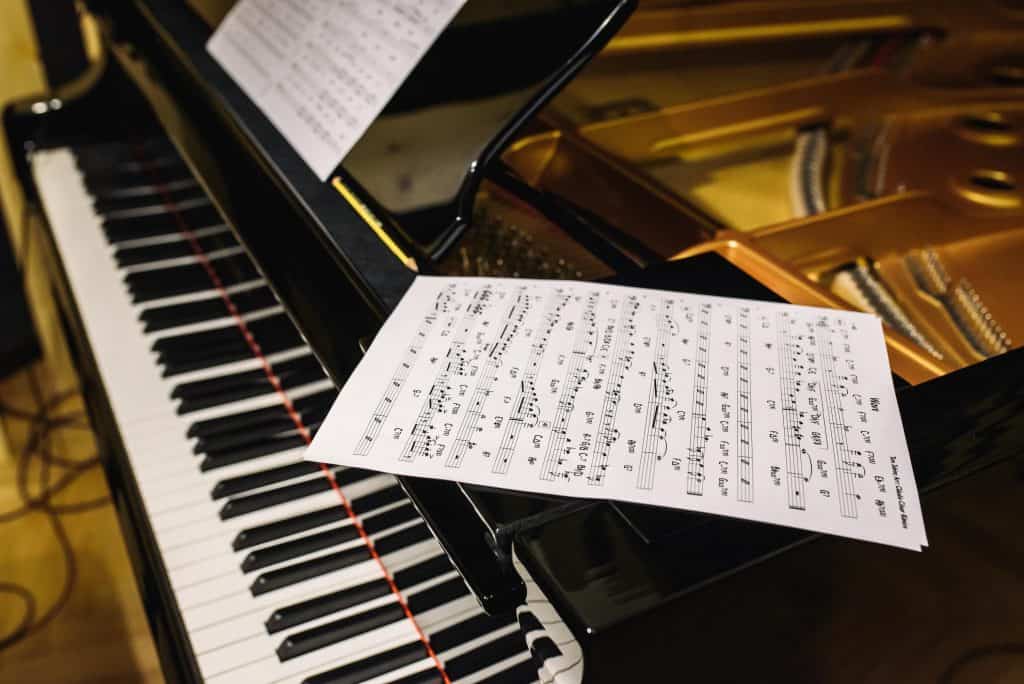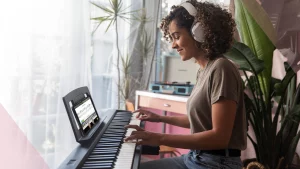Reading two clefs simultaneously is one of the most unique musical challenges available and the piano is virtually the only instrument that requires us to do so. When you get in the zone of reading two clefs at the same time, you enter a true flow state. It is quite amazing and well worth pursuing.
Like all things musical, learning to read music on two clefs simultaneously is not an easy feat. It takes consistency and effort, but is well worth the time. Read on to open the amazing universe of reading two clefs at once!

What are the two piano clefs?
Piano music is primarily notated in the treble and bass clefs. When combined, the treble clef and bass clef form the grand staff notes. The grand staff is divided by middle C.
- The treble clef notes begin with E4 on the first line and continue up to F5 on the top line.
- The bass clef notes begin with G2 on the first line and continue up to A4 on the top line.
If you need a refresher course on the notes of the grand staff, Skoove has great online piano lessons all about reading music. Check out some lessons this week and brush up your reading skills!
Tips to help you read both clefs simultaneously
Reading both clefs simultaneously is a superb challenge. Fortunately, there are some simple ways to enhance your skills and practice efficiently so that you develop quickly.
Practice each clef separately
First, make sure you feel comfortable reading both the treble clef and bass clef separately. You can easily learn to read the treble and bass clef piano notes with Skoove.
Practicing each clef separately is very similar to practicing each hand separately when we are learning a difficult piece of music. By making sure we have adequately mastered each clef, we will need to spend less time thinking about the notes when we read and more time playing!
Start with easier pieces
Of course, a simple trick to helping you efficiently master reading both clefs is to start with simpler pieces. Ideally, begin with pieces that feature both hands in unison. That way, you become accustomed to reading identical notes in both clefs and you develop an understanding of where the notes lie on the staff.
Do you know the relationship between the unison notes of the treble and bass clefs? The unison notes in treble clef are found one line or space lower in bass clef. For example, there is a C on the third space of treble clef and on the second space of bass clef. There is an F on the fifth line of treble clef and on the fourth line of bass clef. There is an A on the second space of treble clef and on the first space of bass clef. See the connection?
Practice coordinating your hands
One of the more difficult parts of learning the piano is mastering the coordination of your hands. It is no easy feat to move both of your hands together on the piano, let alone in opposite directions!
You can use simple patterns like scales and chords to practice coordinating your hands. Practicing your scales and chords in parallel and contrary motion (opposite directions) through as many keys as possible will help you to develop great hand coordination in a relatively short amount of time. Like all things, consistency is key!
Additionally, you could check out a piano pattern method book like the Hanon or Czerny exercises. Both of those books provide a wealth of patterns and information that you can use to strengthen your coordination and dexterity! Not to mention, they both provide great reading practice!
Recognize patterns like chords and intervals
The best piano music readers learn how to identify chords, intervals and other patterns with ease. Learning to read like this will help you to read piano sheet music faster. Think about how you read words on a page. Do you sound out every single letter and syllable in a word when you read? Or do you recognize words, phrases, and patterns in your reading?
Of course, you see letters when you read. Similarly, you should practice training yourself to see the common patterns in music. For example, basic piano chords are an easily recognizable pattern on the piano. Every basic piano chord follows the same pattern, either three lines stacked in a row or three spaces stacked in a row. If you can quickly identify the root note at the bottom, you have to think far less than if you need to sound out every note in the pattern.
The same concept is true for scales and piano intervals. If you can see basic scale patterns in music, which are often notated in fast runs of eighth or sixteenth notes, you will not have to spend time analyzing the music as intently and can focus more on your performance. With intervals, you can learn to identify common intervals of major and minor thirds, perfect fourths and fifths, and octaves with relative ease. All it takes is a little time and effort and some lessons from Skoove!
Read in-between the lines
When you practice all of these skills above, you will find that learning to read both clefs at the same time becomes much easier. You will find that eventually you do not focus so much on one clef separately from the other. Instead, you will find that your eyes focus somewhere in the middle of the two clefs and that you literally read between the lines. This is the most advanced stage of reading piano music. It is fully attainable as long as you put in the time and effort to practice!
Summing it up
Learning to read both the treble and bass clef together in separate hands on the piano is no small feat. It is almost like reading two different languages at the same time and translating them both into writing simultaneously! Fortunately, there are many strategies you can use to master this crucial piano playing skill such as:
- Mastering each clef separately
- Choosing pieces appropriate to your skill-level
- Practicing basic coordination exercises
- Learning to recognize patterns like chords, scales, and intervals
- Practicing reading between the lines
Of course, all of these strategies will require time and effort. There is no shortcut way to becoming a great reader. However, using the tools available to you through Skoove will help you on your way to become a great pianist! Check out a free 7-day trial and you are sure to find songs, scales, and skills you love!
Author of this blog post:

Eddie Bond is a multi-instrumentalist performer, composer, and music instructor currently based in Seattle, Washington USA. He has performed extensively in the US, Canada, Argentina, and China, released over 40 albums, and has over a decade experience working with music students of all ages and ability levels.














